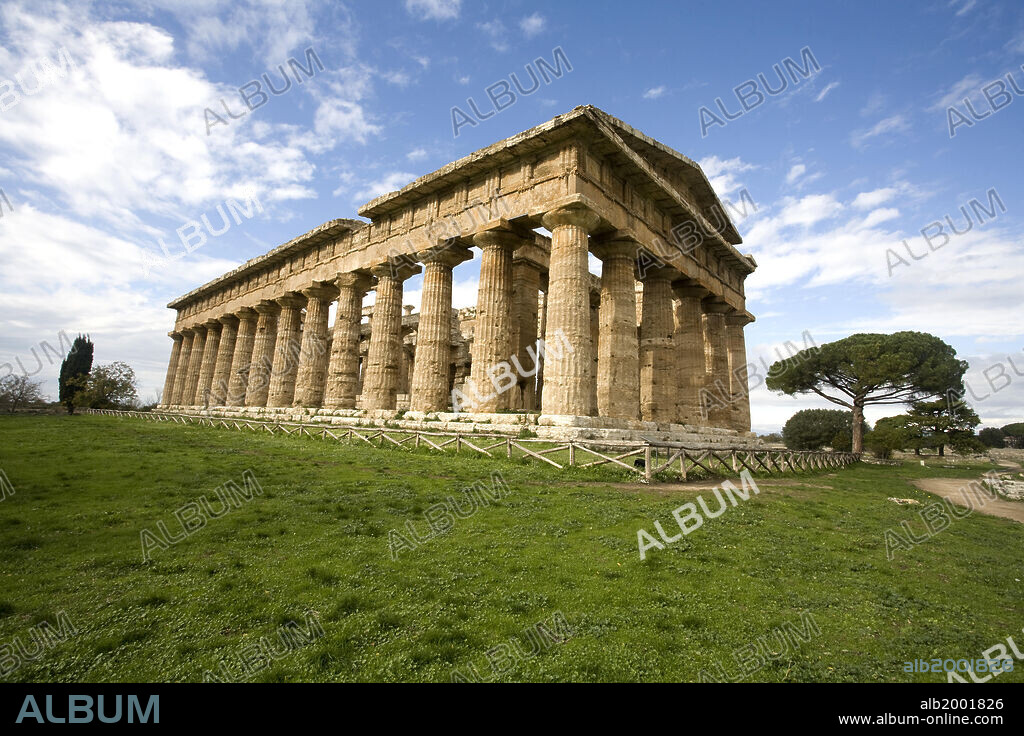alb2001826
Italy, Paestum (Poseidonia), Temple of 'Neptune', eastern facade

|
Ajouter à une autre Lightbox |
|
Ajouter à une autre Lightbox |



Avez-vous déjà un compte? S'identifier
Vous n'avez pas de compte ? S'inscrire
Acheter cette image

Titre:
Italy, Paestum (Poseidonia), Temple of 'Neptune', eastern facade
Légende:
Voir la traduction automatique
The best preserved of the temples of Magna Graecia is the Temple 'of Neptune' at Paestum (Greek Poseidonia), so called because it seemed logical that the most imposing temple in the city had been dedicated to the god for whom the city was dedicated - Poseidon (Neptune). Today the temple is thought to have been dedicated to Apollo, Zeus or Hera, and it is also known by the name "Temple of Hera II" (or "Second Temple of Hera"). The temple is a Doric hexastyle peripteros, with 6 columns in the facades and 14 columns on each of the sides. It has a raised cella (shrine) flanked by distyle in Antis porticoes and approached by steps. The temple also stands on a stepped crepidoma with three steps. The temple probably dates from between 474 and 450 BC. Thanks to its near-perfect state of preservation it is considered an ideal model of the Doric temple of the Classical period. The archaeological site of Paestum is included in the Cilento and Vallo di Diano National Park, that was declared a World Heritage Site by UNESCO in 1998.
Crédit:
Album / Sites and Photos
Autorisations:
Modèle: Non - Propriété: Non
Questions sur les droits?
Questions sur les droits?
Taille de l'image:
10630 x 7087 px | 215.5 MB
Taille d'impression:
90.0 x 60.0 cm | 35.4 x 23.6 in (300 dpi)
Mots clés:
5E SIECLE AV. J. -C. • 5E SIECLE AV. J.-C. • 5E SIECLE AV. JC • 5EME S AV NE • ARBRE • ARBRES • ARCHÉLOGIE • ARCHEOLOGIE • ARCHÉOLOLOGIE • ARCHITCETURE • ARCHITECTURE • ARCHITECTURE: COLONNE • ARCHITECTURE: FACADE • ARCITECTURE • BLEU • CAMPANIE • COLONNE • COLONNES • CULÉE • DEHORS • EN PLEINE NATURE • FACADE • HISOIRE • HISTOIRE • HORIZONTALE • ITALIE • JOUR • PARC NATIONAL • PERIPTERE • PILIER • RELIGION • TEMPLE • TEMPLES • UNESCO • VERT • VUE PLONGEANTE
 Pinterest
Pinterest Twitter
Twitter Facebook
Facebook Copier le lien
Copier le lien Email
Email
